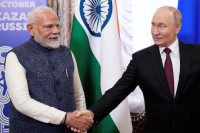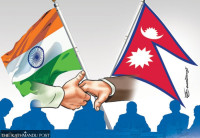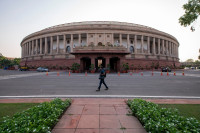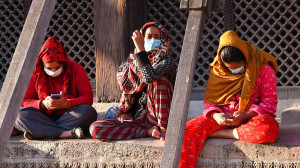Columns
Cities, people and environment
It is vital to ensure that cities are engines of inclusive and sustainable growth.
Pragya Pradhan & Prabal Dahal
Urbanisation is a global mega trend, with over half of the global population now living in urban areas, and by 2050, it is projected to reach two-thirds. Cities are often called the engines of economic growth, generating over 80 percent of the global GDP. Cities are dynamic and offer multitudes of opportunities that attract people from all economic strata. In Nepal, 27 percent of the population lives in urban areas and 40 percent in peri-urban or urbanising areas, according to the Degree of Urbanisation report. Besides metro and sub-metropolitan cities, the agglomeration around them and emerging cities along the dominantly peri-urban areas of Tarai are shaping the urbanisation pattern and demographic shifts in Nepal.
But cities are equally pressed with challenges of mounting population influx resulting in unplanned expansion, deficit services, rising pollution, environmental degradation and increasing inequalities. Globally, cities produce over 70 percent of greenhouse gas emissions, and by 2100, they will be warming by 4 degrees Celsius—twice the global average. Cities are also at the frontline of the climate crisis, with amplified impacts due to an accumulation of risks and vulnerability, that disproportionately impact the urban poor, marginalised and informal settlers.
Hence, it is critical to ensure that cities are also engines of inclusive and sustainable growth. Unmitigated climate risk is expected to cost Nepal 2.2 percent of its annual GDP by 2050, as evident from the flood in Kathmandu valley in September 2024, increasing urban heat, water scarcity and other climate-induced disasters.
Every year, on November 8, the ‘World Town Planning Day’ is celebrated globally; this year with the theme: “With Planning, We Can”. As the world prepares for COP30, the theme resonates globally as well as nationally, emphasising the transformative power of urban planning in achieving climate-resilient and inclusive development, which is now non-negotiable.
Urban planning offers a unifying framework and is a societal tool that helps integrate physical, social, economic and environmental sectors (land, housing, basic services, mobility, open spaces, infrastructure, waste, environment, economy, etc.). It brings together sectoral actors and local stakeholders to work on a common functional and physical space for building, managing and promoting resilient, inclusive and prosperous communities. The urban planning process guides local actions to contribute to the city’s vision that aligns with national policies and plans. Climate actions, both adaptation and mitigation, need to be embedded in this process that ensures development decisions and investments are informed by risks and that the development benefits reach the last mile.
However, in our context, urban planning is largely misunderstood as a complex, expensive, technocratic and usually top-down approach that is beyond the comprehension of local stakeholders. As a result, we often find local development investments are not strategic or yield durable solutions to the urban challenges, and often increase vulnerabilities and disparities. Good urban planning is not expensive, but no or bad urban planning is. Urban planning is simply about making collective conscious choices, informed by the data available today, while looking forward to the kind of city we all want to live in tomorrow.
Already, the municipalities in Nepal are undertaking a participatory annual 7-step planning process. As a small win, the opportunity is to localise and embed a risk-informed and inclusive urban planning process within this existing municipal planning cycle.
The Ministry of Urban Development is preparing a municipal urban planning guideline that presents a step-by-step process to integrate an urban planning approach in the municipal planning process, with technical support from UN-Habitat. This guideline, prepared in consultation with wider national and sub-national stakeholders and being tested at the municipalities in collaboration with UNOPS and Cities Alliance, aims to contribute towards climate and inclusion-responsive urban development.
A major learning during the testing of the localising process is the need to build awareness in city leaders and stakeholders on the importance of urban planning, while also enabling planners and technical experts to dialogue on urban planning in a language that people understand and relate to. Furthermore, the actual roll-out and implementation is only possible with at least an urban planner and strengthened technical capacity within the municipality, who can guide the people-centric participatory process. Hence, it is time that the position and role of urban planners in municipalities are recognised and internalised.
Another learning while embedding climate responsiveness in municipal planning was the need to scale up cost-efficient, durable and locally implementable adaptation solutions. Based on the experience of Urban Ecosystem-based Adaptation (EbA) initiatives of the Kathmandu Valley Development Authority, urban EbA is strongly evolving as an effective approach to bring nature back to our cities to help tackle urban climate challenges with co-benefits. Riverside greening, water management through conservation of local ponds and wetlands, permeable public open spaces and groundwater recharge are some examples of ecosystem-based adaptation that Nepal has been practising since time immemorial. This EbA approach, blended with engineering intervention, has proven to support carbon sequestration, in addition to building resilience against flooding, heat, drought and landslides.
“Cities are where the climate battle will largely be won or lost.” These words from UN Secretary-General António Guterres echoed during the panel discussion while emphasising the roles of urban areas in addressing the climate crisis. The key takeaways of the discussion included the need for translating policies (National Urban Policy, Climate Change Policy, NAP and NDC 3.0) into local-level actions, which requires strengthening the capacity of local governments, along with adequate resources.
Local units should be able to access climate financing directly to undertake climate actions that reduce risks to their communities. The panellists agreed on the priority to increase awareness and understanding of EbA and nature-based solutions (NbS), as it requires societal actions to win the climate battle. The session highlighted the need to consolidate fragmented data, knowledge, and best practices within institutions to build a solid knowledge repository for informing decisions. In a developing country like Nepal, it is also important to enhance capacity and institutional collaboration for effective urban development, as a multi-sectoral priority and at multiple levels of the government.
Local units have the mandate to protect the environment, conserve biodiversity and regulate activities that impact ecosystems. Building on this, urban municipalities should be equipped to perform risk-informed planning and take effective decisions that build adaptive capacity, especially of the most at-risk communities, both spatially and socially. With conscious planning, we can definitely build resilient and inclusive communities.




 16.12°C Kathmandu
16.12°C Kathmandu














%20(1).jpg&w=300&height=200)

